#among us indonesia
Text
Happy 78th Indonesian Independence Day, 17 August 2023

8 notes
·
View notes
Text
Very interesting indeed! Check this out!👇
LAW OFFICES OF AISSA WAYNE (John Wayne's Daughter) Obama's SS Number
For those of you who don't know but at the very bottom of this article the attorney who authored this article is John Wayne's daughter, Aissa Wayne, also a USC graduate.
Well, Well, Well, it looks like someone thoroughly checked this out! I was wondering who was going to do research into President Obama's Social Security number.
Jean Paul Ludwig or Barack Hussein Obama? S . S . N#042-68-4425
WOW, read this, it's short - very interesting.
An intensive 6-year investigation has revealed the identity of the man whose Social Security Number (SSN) is being used by President Obama.
Jean Paul Ludwig, who was born in France in 1890, immigrated to the United States in 1924, and was assigned SSN 042-68-4425 (President Obama's current SSN) rec'd on or about March 1977.
Mr. Ludwig lived most of his adult life in Connecticut. Because of that, his SSN begins with the digits 042, which are among only a select few reserved for Connecticut residents.
Barack H. Obama never lived or worked in that state! Therefore, there is no reason on earth for his SSN to start with the digits 042. None whatsoever!
Now comes the best part! J. P. Ludwig spent the final months of his life in Hawaii, where he died.
Conveniently, Obama's grandmother, Madelyn Payne Dunham, worked part-time in the Probate Office in the Honolulu Hawaii Courthouse, and therefore had access to the SSNs of deceased individuals.
The Social Security Administration was never informed of Ludwig's death, and because he never received Social Security benefits there were no benefits to stop and therefore, no questions were ever raised.
The suspicion, of course, is that Dunham, knowing her grandson was not a U.S. Citizen, either because he was born in Kenya, or became a citizen of Indonesia upon his adoption by Lolo Soetoro, simply scoured the probate records, until she found someone, who died who was not receiving Social Security benefits, and selected Mr. Ludwig’ s Connecticut SSN for her grandson, Barry Obama.
Just wait until the head Birther himself, Donald Trump, gets past the birth certificate and onto the issue of Barry O's use of a stolen SSN. You will see leftist heads exploding, because they will have no way of Defending Obama.
----------------------------------------------------
Although many Americans do not understand the meaning of the term "natural born", there are few who do not understand that if you are using someone else's SSN it is a clear indication of fraud, and a federal offense.
Let's all get this information out to everybody on our mailing lists. If the voters of this great nation can succeed in bringing this lying, deceitful, cheating, corrupt, impostor to justice it will be the biggest and best news in decades for our country and the world. 🤔
"In God We Trust." 💫
#pay attention#educate yourselves#educate yourself#knowledge is power#reeducate yourself#reeducate yourselves#think for yourselves#think about it#think for yourself#do your homework#do some research#do your own research#ask yourself questions#question everything#obama#truth
437 notes
·
View notes
Text
The Best News of Last Week - May 15, 2023
🐕 - Now It's a Paw-ty
1. World's oldest ever dog celebrates 31st birthday

Bobi was born on 11 May 1992, making him 31 years old, in human years. A big birthday party is planned for Bobi today, according to Guinness World Records.
It will take place at his home in the rural Portuguese village of Conqueiros in Leiria, western Portugal, where he has lived his entire life.
2. The FDA has officially changed its policy to allow more gay and bisexual men to donate blood

The Food and Drug Administration (FDA) has announced that they’ve eased restrictions on blood donations by men who have sex with men in an effort to address blood shortages. The new policy recommends a series of individual risk-based questions that will apply to all donors, regardless of their sexual orientation, sex, or gender. Gay or bisexual men in monogamous relationships will now be permitted to donate blood.
3. Illinois passes bill to ensure community college credits transfer to public universities

The Illinois General Assembly has passed a bill that would help community college students transfer to public universities.
It would ensure that certain classes taken at community colleges could be transferred to any higher education institution in the state. Some schools currently only count community college coursework as elective credits.
4. Brazilian President Lula recognizes 6 new indigenous territories stretching 620,000 hectares, banning mining and restricting farming within them

Brazilian President Luiz Inácio Lula da Silva has decreed six new indigenous reserves, banning mining and restricting commercial farming there. The lands - including a vast area of Amazon rainforest - cover about 620,000 hectares (1.5m acres).
Indigenous leaders welcomed the move, but said more areas needed protection.
5. More than 1,000 trafficking victims rescued in separate operations in Southeast Asia
More than 1,000 trafficking victims were rescued in separate operations in Southeast Asia over the last week, officials in Indonesia and the Philippines said.
Indonesian officials said Sunday they freed 20 of their nationals who were trafficked to Myanmar as part of a cyber scam, amid an increase in human trafficking cases in Southeast Asia. Fake recruiters had offered the Indonesians high-paying jobs in Thailand but instead trafficked them to Myawaddy, about 567 kilometers (352 miles) south of Naypyidaw, the capital, to perform cyber scams for crypto websites or apps, said Judha Nugraha, an official in Indonesia's Foreign Affairs Ministry.
6. A peanut allergy patch is making headway in trials

An experimental “peanut patch” is showing some promise for toddlers who are highly allergic to peanuts. The patch, called Viaskin, was tested on children ages one to three for a late-stage trial, and the results show that the patch helped children whose bodies could not tolerate even a small piece of peanuts safely eat a few.
After one year, two-thirds of the children who used the patch and one-third of the placebo group met the trial’s primary endpoint. The participants with a less sensitive peanut allergy could safely tolerate the peanut protein equivalent of eating three or four peanuts.
7. Critically endangered lemur born at Calgary Zoo

The Calgary Zoo has released pictures of its newest addition, a baby lemur. The zoo says its four-year-old female black-and-white ruffed lemur, Eny, gave birth on April 7. The pup’s father is eight-year-old Menabe. The gender of the pup has not been confirmed but the Calgary Zoo says the pup appears bright-eyed and active and is on the move.
The black-and-white ruffed lemur is registered among the 25 most endangered primates in the world, due mostly to habitat loss and hunting.
----
That's it for this week :)
This newsletter will always be free. If you liked this post you can support me with a small kofi donation:
Buy me a coffee ❤️
Also don’t forget to reblog.
SUBCRIBE HERE for more good news in your inbox
657 notes
·
View notes
Text
Unconventional warfare constituted the US method of choice to weaken or overthrow unwanted governments. It was designed to “roll back” governments deemed detrimental to US interests and those of global capital. Such strategies depended almost entirely on para-institutional complexes. US agencies liaised with and coordinated complexes of local collaborators, insurgents, militias, “secret” armies, mercenaries, private air-military contractors and other para-institutional forces to influence the political and economic orientation of foreign states. These efforts to weaken unwanted foreign governments or towards regime change extended around the world to countries such as Albania (1949–53), China (1949–60s), Burma (Myanmar) (1951–53), Tibet (1959–60s), Iran (1953), Guatemala (1954), Syria (1956–57), Egypt (1957), Indonesia (1957–58 and 1965), Iraq (1963), North Vietnam (1945–73), Cambodia (1955–70), Laos (1958–63), Cuba (1959–present), Chile (1964–73), Greece (1967), Bolivia (1971), Zaire (1975), Angola (1975, 1980s), Seychelles (1979–81), Libya (1980s), Grenada (1983), South Yemen (1982–84), Nicaragua (1981–90), (Afghanistan 1979–89), Fiji (1987), among others.
Andrew Thomson, Outsourced Empire: How Militias, Mercenaries, and Contractors Support US Statecraft
130 notes
·
View notes
Text
The Colugo: these mammals are able to glide through the air using a fur-covered membrane that stretches across their bodies; as a baby, a colugo that has not yet learned how to glide on its own must cling to its mother's belly instead
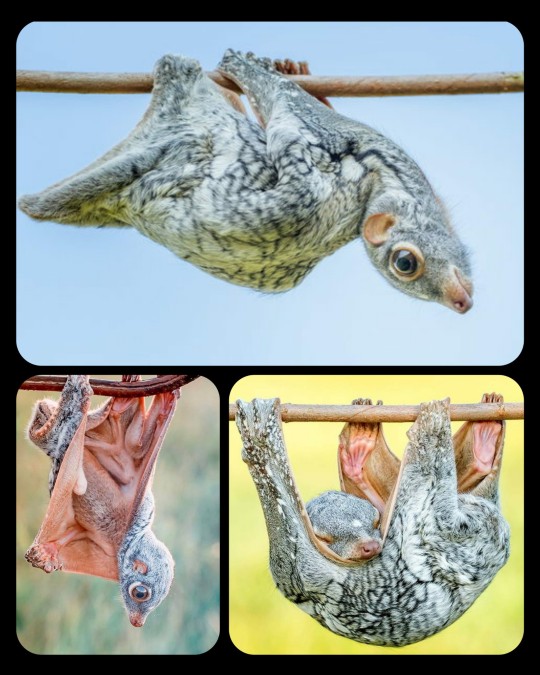
These critters are often referred to as "flying lemurs," though they aren't actual lemurs. Genetic studies have indicated that they are among the closest living relatives of primates, occupying a sister group.

Colugos are native to the tropical rainforests of Southeast Asia, where they are traditionally divided into two extant species: the Philippine flying lemur (Cynocephalus volans), which resides in the Southern Philippines, and the Sunda flying lemur (Galeopterus variegatus), which can be found in parts of Vietnam, Laos, Cambodia, Thailand, Myanmar, Malaysia, and Indonesia.
The fur-covered membrane that stretches across the colugo's body is known as a patagium; a similar membrane can be found in other gliding mammals (e.g. flying squirrels, sugar gliders, mahogany gliders, etc.) but the patagium of the colugo is uniquely extensive, surrounding almost all of the animal's body margin and stretching even between the tail and hind legs.
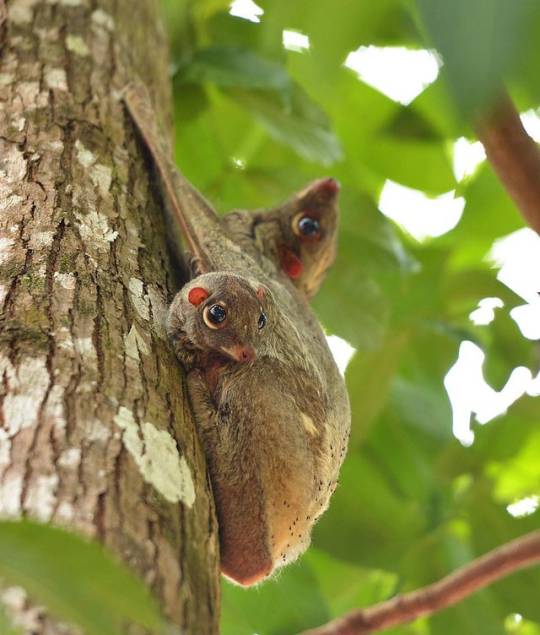
When they are not actively gliding, female colugos often pull their tails up against their bellies, effectively curling the patagium into a pouch in which they can carry/protect their young. When gliding, however, the mother must fully extend her patagium, meaning that she has to unfold the pouch and allow the baby to curl itself around her torso (and hold on tight) befor she can begin gliding.
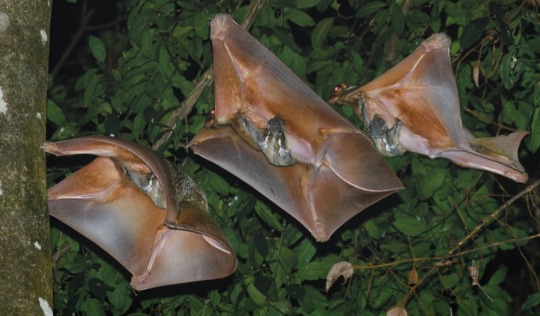
Colugos have a more extensive patagium (and therefore possess more "wing space") compared to other gliding mammals, which enables them to glide much further. There is at least one documented case in which a Sunda colugo was observed gliding across a distance of 145 meters -- nearly the length of three Olympic-sized swimming pools. Another study also indicates that this species is able to glide a total distance of 1,342 meters per night (and can climb a total of 320 meters up into the trees in order to do this).
These critters also have extremely strong claws, and the soles of their feet are able to mimic suction-cups to help them maintain a tight grip on tree trunks and branches. Colugos are most active at night, and they are strictly herbivorous, feeding only on young tree leaves.
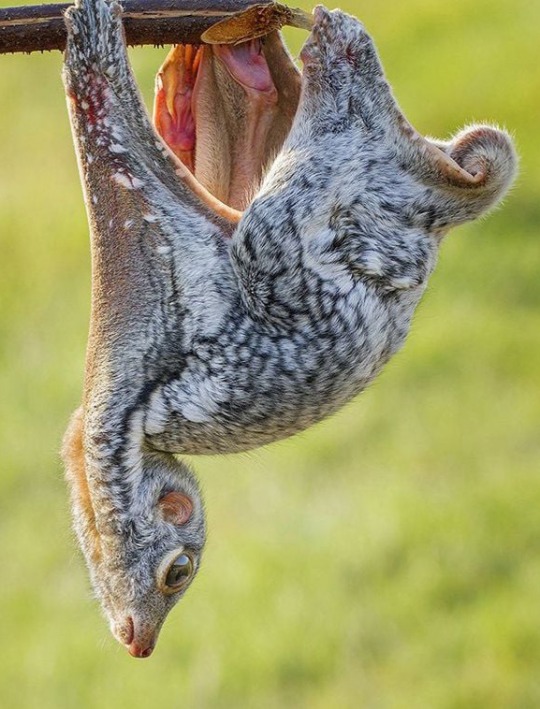
I don't normally feature mammals on my blog, but this one in particular seemed too heartbreakingly adorable and too weird for me to ignore. I mean, look -- it's like a tiny dinosaur wrapped in a Snuggie!
Sources & More Info:
Science News: On a cool night in Malaysia, scientists track mysterious colugos across the treetops
Animal Diversity Web: Galeopterus variegates (the Sunda flying lemur)
BioMed Central Journal of Biology: Colugos -- obscure mammals glide into the evolutionary limelight
World Wildlife Fund: Flying Lemurs
National Geographic: Why do flying lemurs glide?
Encyclopedia Britannica: Flying Lemur
Animal Diversity Web: Cynocephalus volans (the Philippine flying lemur)
#animals#nature is weird#science#biology#zoology#flying lemurs#gliding mammals#cute#weird animals#sunda#nature#colugo#these#guys#probably#give#the#very#best#hugs
613 notes
·
View notes
Text

If you want to see how harmful this “digital nomadic culture” is, you just need to look at what they’ve done to Bali, Indonesia. They have completely displaced local residents and pushed them out of their communities because locals can no longer afford to keep up with the COL.
Original post: "They bore me so much🫥" with the caption from an Instagram story of. woman dining: "GIRL MATH: You've figured out the ultimate life hack as a millenial is to make you money in the US and live abroad where the cost of living is more affordable."
There's so many layers to unpack here. 'Tourism' in the Caribbean, for instance, is something I think about as well whenever I see people acting like this -these industries, which are highly exploitative towards the people and their communities and environments is one element -but the 'travelling to paradise' market itself is based in neo/colonialist frameworks and current mentalities and that itself is something that needs to be addressed much more. Especially with what is happening in Jamaica where so many Jamaicans are being pushed out of their own land when a tourist 'resort' wants to build or 'expand' because these 'ideal' locations are near the sea, where Jamaican people have been/are fishing for their own livelihoods and survival. I posted a video about this, but for those who haven't looked into these issues -I implore you to look into this.
I also think of Hawai'i, which has had many devastating impacts to their islands this past year -irreparable damages to both Native Hawaiians and the environment (and ongoing issues, such as the water being contaminated/and scarce there and yet tourists are prioritized for access to clean water sources) -and STILL people remained and traveled there during the Maui fires, and just overall despite countless pleas for them not to go they still do.
Among many the 'desirable destinations' marketed specifically to Europeans/Westerners as 'a getaway to' where they can detach from their busy lives, or to live permanently because it's 'too expensive' where they live -I sincerely wish they would come back down to earth and realize their imperialistic mentalities -especially when going to countries whose economies they perceived as 'poorer,' without looking critically at the country's infrastructure and history is just willful ignorance at best.
#feminist#feminism#tourism#tourist#gentrification#settler colonialism#colonialism#colonial violence#eco terrorism#hawaii#imperialism#western imperialism#travelling#travel#the caribbean#jamaica#dominican republic#bali#indonesia
108 notes
·
View notes
Text

Flask-Shaped Pitcher Plant (Nepenthes ampullaria)
Family: Typical Pitcher Plant Family (Nepenthaceae)
IUCN Conservation Status: Least Concern
Most species of pitcher plants are carnivorous, using jug-like, fluid-filled traps that protrude from their leaves to capture small animals and digest their bodies, absorbing the nutrients released (particularly nitrogen, which is needed to produce chlorophyll and which is scarce in the soil around them due to intense competition with other plants) across the trap's inner walls. The Flask-Shaped Pitcher Plant, however, is unusual among its relatives in that it is seemingly essentially a herbivorous plant - found in damp, dense forests, it grows as a woody vine that creeps along the ground or through the lower branches of larger plants and uses its unusually short, wide pitchers to catch leaves that fall down from the trees above it, digesting them to make use of the nitrogen and other nutrients they contain. Widely distributed across much of Brunai, Indonesia, New Guinea, Malaysia, Thailand and Singapore and reportedly quite common in damp, humid environments throughout their range, members of this species are dioecious (meaning that each individual plant is either "male", producing pollen-producing flowers, or "female", producing pollen-receiving flowers that develop into seeds once pollinated,) and produce dense clusters of small, petal-less flowers relatively high in their "branches", typically far from their traps to avoid accidentally trapping pollinators. Once pollination has occurred, "female" flowers produce numerous tiny, lightweight, hair-like seeds which are carried away from their "mother" on the wind.
----------------------------------------
Image Source: Here
#Flask-shaped pitcher plant#pitcher plant#pitcher plants#nepenthes#carnivorous plant#carnivorous plants#botany#biology#wildlife#plant#plants#Asian wildlife#Nepenthes
95 notes
·
View notes
Text
[ENG translation] Joker Out at Eurosonic 2024: an interview with Kris for Val 202 radio station
Today, 22.01.2024, Slovenian radio station Val 202 broadcasted an episode of their 'Glasbena zgodba' ('Musical Story') podcast about the Eurosonic 2024 festival that happened last week. Eurosonic is an annual showcase festival and music conference in Groningen, The Netherlands, where emerging European acts perform for industry professionals and festival scouts. Joker Out performed there this year, so today's podcast featured a short interview with Kris Guštin. You can find the original post here or listen to the original audio in Slovenian in the embed above. Here is the translation of the interview, translated by a member of Joker Out Subs and proof read by @flowerlotus8.
Host: The first group we mentioned, Joker Out, performed twice during the festival. First on Wednesday on the MAAS main stage, and the next day, on Thursday, in the Platosonic record shop, where The Strokes also performed in the past. I invited Kris Guštin, who talked to the fans there in Dutch, in front of the microphone.
Kris: Well, my great-grandma and my grandpa's entire side of the family, who are from Indonesia, live in a place called Assen, which is 30 minutes out of Groningen. It's actually the closest big city for them.
Host: Joker Out haven't performed at many showcase festivals, Kris counts Eurovision and the PIN festival in Skopje among them.
Kris: Showcase festivals are maybe not that important or necessary for us anymore, but we still liked doing one or two, to experience it. It is, however… For performers who are really still looking for an international audience, and especially those who would like to present themselves to industry people from abroad, it's a pretty great chance. It's the same with MENT¹, for Slovenia, of course.
Host: Were you thinking about, or were you under any pressure, considering that there were many music professionals in the audience?
Kris: Not really. It's… We were aware that it would be harder to make a good show, because people wouldn't be that oriented towards us and our music, which is totally understandable. I have to say, however, that I was honestly surprised and happy that we had the first three rows or so of our fans, who really made the atmosphere more lively, otherwise it would've been pretty hard. I did, however, also see... The best kind of validation is to see these people who, at the beginning, are standing in the back and not participating in the concert, who are then bobbing their heads by the end. That's always a good sign of a good concert.
Host: The members of Joker Out, who will release a new single in February and go on another European tour soon after that, are currently living in London, where they are getting used to life there and, as Kris says, creating new music outside of their comfort zone.
Kris: But just as a fun fact, well, I will say that now that we are in London, we've made a song that is the most Balkan song we've ever made, so it's… it might have a completely opposite effect. We don't really have any idea yet where it will take us.
Host: In Slovenia, you made a living with music. Now that you've gone abroad and have all these concerts, is it as profitable as laypeople imagine?
Kris: I'll say it like this: if we stayed only in Slovenia, we would be making more money right now than we actually do. But we have, I don't know, some kind of a chronic flaw where we never know how to stop investing in ourselves, well, how to say it. Which is actually a great thing, but such... touring abroad is definitely not a profitable thing for a band at our level, but I will say that it is less of a financial burden than I thought it would be. We are lucky to have so many listeners that in the previous season, the previous tour, we sold out almost everything, which means that it did bring us some money, but with all the... plane tickets, accommodation, transport, it amounts to so much that in the end, we just managed to nicely finance all of it, plus maybe get some money for the album this year. Otherwise, it's not like we're making big money. If we had stayed in Slovenia, we would've just pocketed all that.
¹MENT Ljubljana is one of the leading showcase festivals and music conferences in Central and Eastern Europe and the largest event of its kind in the region.
55 notes
·
View notes
Text
💢 Very interesting indeed! Check this out!!🧐🤔⬇️
LAW OFFICES OF AISSA WAYNE (John Wayne's Daughter) Obama's SS Number
For those of you who don't know but at the very bottom of this article the attorney who authored this article is John Wayne's daughter, Aissa Wayne, also a USC graduate.
Well, Well, Well, it looks like someone thoroughly checked this out! I was wondering who was going to do research into President Obama's Social Security number.
Jean Paul Ludwig or Barack Hussein Obama? S . S . N#042-68-4425
WOW, read this, it's short - very interesting.
An intensive 6-year investigation has revealed the identity of the man whose Social Security Number (SSN) is being used by President Obama.
Jean Paul Ludwig, who was born in France in 1890, immigrated to the United States in 1924, and was assigned SSN 042-68-4425 (President Obama's current SSN) rec'd on or about March 1977.
Mr. Ludwig lived most of his adult life in Connecticut. Because of that, his SSN begins with the digits 042, which are among only a select few reserved for Connecticut residents.
Barack H. Obama never lived or worked in that state! Therefore, there is no reason on earth for his SSN to start with the digits 042. None whatsoever!
Now comes the best part! J. P. Ludwig spent the final months of his life in Hawaii, where he died.
Conveniently, Obama's grandmother, Madelyn Payne Dunham, worked part-time in the Probate Office in the Honolulu Hawaii Courthouse, and therefore had access to the SSNs of deceased individuals.
The Social Security Administration was never informed of Ludwig's death, and because he never received Social Security benefits there were no benefits to stop and therefore, no questions were ever raised.
The suspicion, of course, is that Dunham, knowing her grandson was not a U.S. Citizen, either because he was born in Kenya, or became a citizen of Indonesia upon his adoption by Lolo Soetoro, simply scoured the probate records, until she found someone, who died who was not receiving Social Security benefits, and selected Mr. Ludwig’ s Connecticut SSN for her grandson, Barry Obama.
Just wait until the head Birther himself, Donald Trump, gets past the birth certificate and onto the issue of Barry O's use of a stolen SSN. You will see leftist heads exploding, because they will have no way of Defending Obama.
---------------------------------------------------------------------
Although many Americans do not understand the meaning of the term "natural born", there are few who do not understand that if you are using someone else's SSN it is a clear indication of fraud, and a federal offense.
Let's all get this information out to everybody on our mailing lists. If the voters of this great nation can succeed in bringing this lying, deceitful, cheating, corrupt, impostor to justice it will be the biggest and best news in decades for our country and the world.
"In God We Trust."
84 notes
·
View notes
Text
Indonesia on Tuesday unveiled the National Task Force for Local Currency Transactions, a strategic initiative aimed at reducing the country's reliance on the US dollar in international transactions while promoting the use of its local currency.[...]
Last month, Bank Indonesia inked an agreement with Bank Negara Malaysia and the Bank of Thailand, aimed at promoting the use of local currencies in transactions among these countries.[...]
Indonesia has also entered into local currency transaction agreements with Japan and China and is actively pursuing similar arrangements with Singapore and South Korea.
5 Sep 23
76 notes
·
View notes
Text

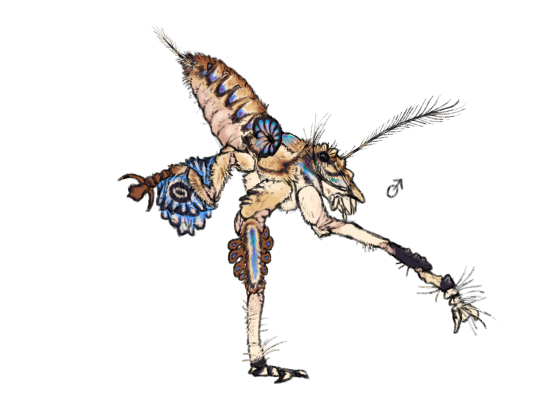
This is a sandwalker, common in the “african” deserts of AfroEuroAustralAsia. These animals belong to a diverse group often called “the Headless”, or “Bluebloods” because most of them look like they lack necks, which isn’t quite true. Their ancestors, the giant malaysian cockroach, ironicaly has a very flexible “neck” for an insect. Some call them “Bluebloods” because they have blue, copper based blood, and also a lot more efficient vascular system than their sixty million years old ancestor. The sandwalkers are rather primitive compared to the other headless, but evolved extremely rapidly like the rest of them.
The malaysian roaches were one of the first animals to re-colonize the islands in oceania devastated by human activity (it was also very common for them to raft since the ocean levels were quickly rising) and so they appeared in an environment with many unoccupied niches and no predators with the exception of birds, that later established populations on said islands too. A lot of the already big roaches grew even bigger because the bigger you are, the more you can eat and the harder it is for the birds to swallow you. Larger individuals would also have slightly different calls due to their body shape, and so they would more likely socialize and mate with similarly sized roaches, resulting in a very slow sympatric speciation contributing to the headless’ / bluebloods’ evolution. The manmade nanite activity has driven many species to extinction, but in case of these giant roaches, they speeded up their enlargement process, because the odds we on their side and the nanites caused several random mutations that contributed to the developement of active respiration and later complex vascular system. As the sea levels were decreasing, the islands of what was previously Malaysia, Indonesia, Papua new Guinea and the neighbouring countries, increased in numbers, size and diversity, and so did the headless. They later dispersed into what used to be Australia, where they also thrived. When Australia started colliding with Asia (ca. 50my after human extinction), the headless experienced a huge decline because of the competition from mainland animals, but a few of them have managed to spread far into the west into Africa, which by now was separated from Asia and Europe by tall mountains instead of the sea. And among these bluebloods are the sandwalkers.
Oh and about the organ on the male’s back? These are modified wings. Giant malaysian cockroach females lack wings completely, and so do the sandwalker females. Males use these “wings” to serenade for the females with chirps and buzzes. The hind wing became a stump, while the fore wing went harder and immobile, completely encircled the hind wing and fused with the carapace. Males create these sounds by stridulation, vibrating the hind wing while it is in contact with the grooved carapace. The immobile fore wing acts as a sound amplifier. Different headless species have different shapes of these structures, creating vastly different mating calls. The larger ones make sounds similar to a pitched-down chainsaw and can travel for houndreds of meters.
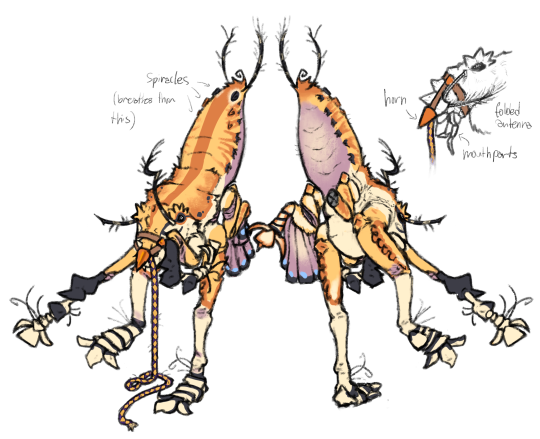
And here’s a bit more cartoonish one. Her name is Head and she belongs to a young Yuo Yowa (a species not introduced yet) merchant who travels around the desert and sells low quality salt for high prices.
#artists on tumblr#creature design#digital art#speculative evolution#worldbuilding#spec bio#spec evo#speculative fiction#oc art#small artist#art
89 notes
·
View notes
Text




If I saw them correctly, the seven flags featured here appear to be the United States, Thailand, Austria, United Nations, Switzerland, Norway, and Indonesia. I might be wrong—they come through so quickly and at differing angles.
It would take an incredible amount of time to really dig into why each of these countries were represented, and I definitely don't have the understanding to do so with confidence in my accuracy. But for context, it is worth noting that at various points from the '50s to the '70s, among other things, the US was responsible for militarizing Austria in anticipation of it becoming "Europe's Korea" during the Korean War, incentivizing and encouraging genocide in Indonesia, and utilized Thailand as their main launching point for the majority of their bombing campaigns in Vietnam.
#again i am not a historian and these were very surface level research observations from me#so i do not have the nuance required to analyze the total effect the US had on these nations throughout the cold war#but i was very curious as to why at least a handful of these were featured in a very clear and literal performative display#that was using charles as a mirror into the amount of unnecessary suffering and death that was perpetuated#so i wanted to give it a gander and had some unfortunately heavy reminders#charles winchester#charles emerson winchester iii#m*a*s*h#mashposting#mashblogging#s8e22#dreams
32 notes
·
View notes
Text

IMAGES: ROKAF performs last Elephant Walk with its F-4 Phantom
Fernando Valduga By Fernando Valduga 03/09/2024 - 18:21in Military
The Air Force of the Republic of Korea (RoKAF) conducted on March 8 an impressive "elephant walk" (Elephant Walk) involving 33 aircraft, including poacher fighters F-35A, KF-16, F-15K and the former F-4E that are scheduled for retirement in June.
The F-4E Phantoms, leading the formation equipped with AGM-142H 'Popeye' and AGM-65D 'Maverick' air-to-ground missiles, and MK-82 air-to-ground pump. A total of 25 newer fighters followed, including the F-15K, KF-16, F-16, FA-50, F-5 and F-35A. Among them, two F-35As flew low over the Elephant Walk formation and then landed and joined the formation.

This demonstration at Suwon Air Base coincided with the annual Freedom Shield exercise, reinforcing the deterrence against North Korea's nuclear and missile threats.
A RoKAF official said that "this is the first time that all types of fighters belonging to the South Korean Air Force have participated".

The term "elephant walk" dates back to World War II, when large fleets of Allied bombers gathered for missions containing up to 1,000 aircraft. It means a coordinated demonstration of power and military preparation.
youtube
The Chief of Staff of the Air Force, General Lee Young-su, emphasized the need of the South Korean Air Force to inspire confidence in the public and deter potential opponents. The "Elephant Walk" demonstrated RoKAF's readiness to respond decisively to any provocations.

"I give a warm applause to the Phantoms who protected the Republic of Korea for 55 years, and to the 'Ghost Men' who shared the ups and downs with the Phantoms," added Lee Young-soo.
The F-4 was first introduced in Korea in 1969. RoKAF explained that it was able to dominate the North Korean Air Force by introducing the F-4D, the new most powerful aircraft in the world at the time. Until the KF-16 entered service in 1994, the F-4 served as the main fighter representing the Air Force of the Republic of Korea, which even operated up to about 220 Phantoms, including the improved F-4E and the RF-4C reconnaissance aircraft.
Most Phantoms are retired and only about 10 F-4Es remain active. All of them will be retired in June of this year.
North Korea's recent calls for mobilization for combat highlight the ongoing tensions in the region, with Pyongyang often seeing negotiations for joint exercises between South Korea and the US as provocations.
Tags: Military AviationElephant WalkMcDonnell Douglas F-4 Phantom IIROKAF - Republic of Korea Air Force/South Korean Air Force
Sharing
tweet
Fernando Valduga
Fernando Valduga
Aviation photographer and pilot since 1992, he has participated in several events and air operations, such as Cruzex, AirVenture, Dayton Airshow and FIDAE. He has works published in specialized aviation magazines in Brazil and abroad. He uses Canon equipment during his photographic work in the world of aviation.
Related news
MILITARY
F-35A fighter officially certified to launch the B61-12 nuclear bomb
09/03/2024 - 14:00
MILITARY
Indonesia updates F-16 AM/BM combat jets to the EMLU standard
09/03/2024 - 12:30
HELICOPTERS
After three months, V-22 Osprey aircraft are released to fly again
09/03/2024 - 11:28
MILITARY
KAI will develop FA-50 single-seat light combat jet
08/03/2024 - 19:17
HELICOPTERS
VIDEO: MH-60R Seahawks helicopters enter service in the Indian Navy
08/03/2024 - 16:00
MILITARY
Colombian Air Force receives augmented virtual reality simulators to train T-6C plane pilots
08/03/2024 - 14:00
21 notes
·
View notes
Text
A writer’s guide to forests: from the poles to the tropics, part 8
We’ve made it to the tropics. I hope you enjoyed this, and found it useful in your writing.
Tropical rainforest
Probably the most recognizable of forest environment, and among the most threatened.
Location-Latin America, Africa, Australia, Indonesia, and the Pacific islands in between the tropics of Cancer and Capricorn. Many forests have been felled or heavily altered by human activity.
Climate-Subtropical to tropical, with conditions being wet year round. Rain does not fall all the time, with a defined rainy and dry season. (What’s the difference? Rainy season has rain almost daily while in the dry season you will have to make do with high humidity and morning fog) At higher elevations, nights are cooler, though still well above freezing, and mist and rain are more common(this is why mountainous RF are called cloud forests)
Plant life- This is a tree dominated environment. The understory and forest floor are dark, unless trees have recently fallen. Many small plants are arboreal, nestled in the upper branches of trees. Vines and other climbers use larger plants as scaffolding. In areas of poor soil, tropical pitcher plants (Nepenthes spp.) and bladderworts (Utricularia spp.) get much needed nutrients from animal sources.
Animal life- Rainforests are the most biodiverse environments on Earth. Insects are everywhere, as are the animals that eat them. Birds and primates can be found from the canopy to the forest floor. The moist conditions make for an ideal habitat for frogs and toads. Apex predators are the big cats-think jaguars, tigers and leopards. Some species of herbivores can be quite large; Africa is home to gorillas and forest elephants, while the island of Borneo, Sumatra, and Java support rhinos and orangutans (though the further of these species is uncertain)Waterways are home to all sorts of fish(there are more species in the Amazon river than in the Atlantic Ocean), and larger animals, such as otters, crocodilians, and even river dolphins. Isolated islands have far fewer mammal species, with bats being the only ones, but hardy insects, reptiles, and birds making up the majority of the biomass. Deforestation and the introduction of invasive species have caused the extinction of many animal species, with island forests being the hardest hit.
How the forest affects the story- When one thinks of societies in the tropics, it usually is through the lens of western stereotypes designed to shock audiences and give ‘civilization’ something to conquer. Avoid this at all cost! There is more to the forest. Before the Spanish conquest, the Amazon was home to cities, and the agricultural societies of New Guinea are believed to be contemporaries with the farmers of Mesopotamia.
Grain does not do well in the tropics, so farming will be based around plants such as açaí, coconuts, taro, breadfruit, bananas, and manioc. These can be supplemented by hunting and fishing, but long term storage will have to be addressed. High humidity is a breeding ground for bacteria and fungi, so organic material will have to be kept dry so they don’t rot. The concentration of microorganisms also means that good hygiene is needed to avoid disease.
Settlement will always cause disruption, and the extent of your character’s activities can have a big impact on the forest, and your story. And remember, the activity of a small village will be different to that of large scale logging. Management, use, and abuse of the rainforest can be a driving factor in the plot. How will your characters react? Is the threat from outside or from within? The destruction of the rainforest is one of the main factors, along with unmitigated greenhouse gas emissions that is causing the current climate crisis. Can your characters do better? Or will you create a cautionary tale that shows us the grim future we are currently barreling towards? (That choice, my dear writers, is completely up to you)
#writing#creative writing#writing guide#writing inspiration#writing prompts#writer#writers#writer on tumblr#writeblr
34 notes
·
View notes
Text
I think the universal language thing doesn't suck as much as people think.
Why this is beneficial?
It Doesn't Place Any Language as the Default
On the global sphere languages like English or French are the de facto lingua Franca. This would put people like Feliks or Yong Soo at a disadvantage. Having a default language that isn't one spoken by a nation as their main language makes it so no one has a clear advantage linguistically
Ease of Communication
Okay imagine all of the nations of Africa meet for a meeting. Thousands of languages are spoken in Africa it's an incredibly linguistically diverse continent. Now how should everyone communicate with one another? Should they emphasize a language like Swahili, English, French, or Arabic? This is what they do IRL in the African Union. But as language is an intrinsic part of identity I don't feel all the nations on a continent would really enjoy that.
Now commonly sited drawbacks and how to get past them
Q: What about forcing language on someone as a symbol of power?
A: Alright, I write mainly Eastern Europe and Russification was and is still a thing. Now does a default language mean Ivan can enforce his language on others? No, he can simply choose not to use it as a form of communication. Add the default nation language to Lithuanian, Polish, Ukrainian, and more after the failed January Uprising. The people of the country don't speak the default nation language. So use this as rationale for Ivan to adhere to Russian being a lingua Franca among the nations of the Soviet Union just as it was back then.
Really i see it like how it was with my friend group in highschool. We all spoke English. Yet I had a friend from Indonesia, Japan, The Czech Republic, and multiple friends from Germany. Sometimes the friends from Germany would spend lunch speaking to one another in German the rest of us not speaking a word of it, just chatted with ourselves entertained.
Q: What about my OTP?
A: your OTP can still learn one another's language. They are learning each other's culture that way and that's important. My best friend's family will speak to me in Spanish because they know I have learned it even though they also speak English as well.
Q: why bother learning a language then?
A: Simple, perhaps the default nation language is quite rudimentary and it can only function to get the basics across. The characters can still be motivated or forced to learn a another language.
Q: what about the people?
As stated before the nation default is only used by nation reps. Take this map of the languages of Interwar Poland. Feliks, if he wants to understand all of his people has probably had to learn some of these languages over the years. To this day Lithuania has Polish speaking minorities so he can use Polish with them. If Feliks is in Sejny or Puńsk for whatever reason or in Hajnówka he can use Lithuanian or Belarusian with those people.
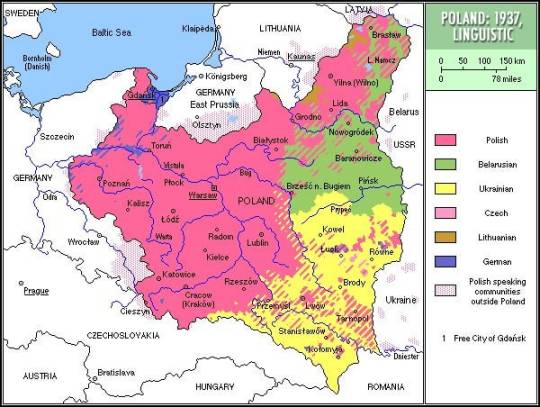
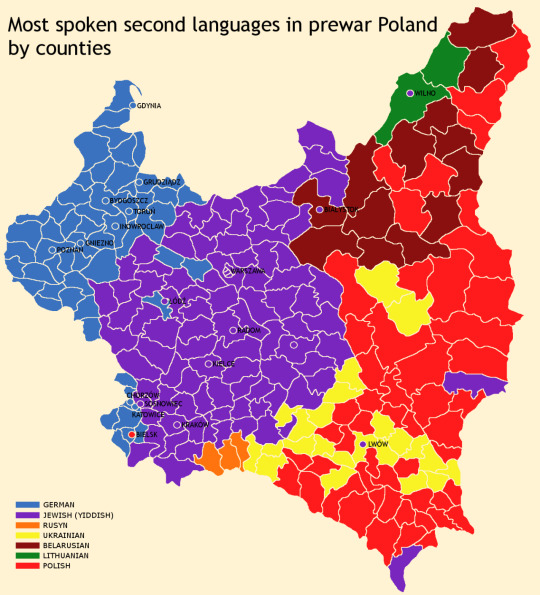
Overall, I don't really care how you go about it this is just my opinion you do you and have fun! 💗
26 notes
·
View notes
Text
Asia’s youngest nation emerges as a voice of conscience on Myanmar
Two decades ago, freedom fighters on a mountainous island in southern Indonesia won a long, bloody struggle against a corrupt military regime, establishing East Timor, also known as Timor-Leste, the first independent state of the 21st century. Memories of airstrikes and indiscriminate killings are still fresh here. And they’ve led the country’s leaders to take an unusual interest in another fight for freedom in Southeast Asia.
In 2021, a group of generals overturned an elected government in Myanmar, formerly known as Burma, starting a civil war that some conflict monitoring groups consider the most extreme in the world today. Many countries have looked away — much as they did for 24 years, East Timor’s leaders say, as Indonesian soldiers fought Timorese independence fighters.
“For so long, nobody paid attention to us,” Xanana Gusmao, the prime minister of East Timor, said during an interview in the capital, Dili.Gusmao led the insurgency against the Indonesian military, later serving two terms as East Timor’s president and now, his second as prime minister. At 77, with a head of white hair and a stiff back from years of imprisonment, he still remembers every person he saw killed or tortured in the jungles of Timor, he said.
“I do not accept the suffering of the Burmese people,” Gusmao said. “I cannot.”
Many in East Timor, even opposition politicians and civil society leaders critical of Gusmao on other issues,said in interviews that they agree. The country of 1.3 million, with an economy one-seventh the size of Vermont, has gone further than almost any other in supporting the Myanmar resistance, receiving its leaders as state representatives and openly advocating on their behalf at international forums.In the coming months, East Timor will let Myanmar pro-democracy groups open offices in the country to help coordinate resistance activities and take in a number of political refugees, officials say.
Increasingly, human rights activists say they see Dili as a voice of conscience, challenging more powerful countries that have been too distracted or too divided to press for change in Myanmar. “What the Timorese are doing is vital,” said Debbie Stothard, a Malaysian rights advocate.
Regional inaction
The U.N. Security Council has repeatedly called on Myanmar’s military government to comply with a peace plan adopted by the Association of Southeast Asian Nations (ASEAN), and Western officials, including from the United States and the European Union, have also cited that plan for resolving the conflict.
But ASEAN, which operates on a principle of “noninterference” and includes Myanmar as a member, has largely failed to convince the junta to cooperate.
In 2021, ASEAN adopted the “Five-Point Consensus” on Myanmar, which calls for a cessation of violence and a dialogue among all parties. The junta signed the plan but has ignored it with little consequence. The military has ramped up airstrikes to a rate of nearly once a day, according to conflict monitoring groups, and faces mounting allegations from human rights groups of carrying out mass killings, beheadings and other atrocities. Myanmar has declined invitations from ASEAN to meet with resistance leaders.
“The five-point consensus has failed,” said Saifuddin Abdullah, who served until last year as foreign minister for Malaysia, an ASEAN member. The plan, which has no enforcement measures, is being disregarded not only by the Myanmar government but by other ASEAN members, Abdullah said.
In April, Thailand’s foreign minister traveled to Myanmar and met with junta leader Gen. Min Aung Hlaing without notifying other ASEAN members. Thailand, which borders Myanmar, has also hosted secret meetings with junta officials and mooted the idea of ASEAN “fully re-engaging” military leaders.
By normalizing relations with the Myanmar opposition, East Timor is trying to pull the region in the opposite direction — but at some risk to itself. The country is in the final stages of negotiating admission into the bloc and was allowed last year to attend meetings as an “observer.” Its outspoken stance on Myanmar could jeopardize its application or otherwise alienate some of its neighbors, analysts say.
East Timor can’t afford to be excluded from ASEAN, Gusmao admitted. With more than 40 percent of its population living in poverty, the country is in dire need of foreign investment. It has 15 years to find an alternative to its dwindling petroleum revenue, according to the International Monetary Fund, and has struggled since independence to feed its people,a problem set only to worsen with climate change.
At the same time, political scientists say, the country’s history has made it particularly sensitive to authoritarianism. East Timor has become probably the most robust democracy in Southeast Asia, according to experts.It’s the only country in the region ranked “free” by the think tank Freedom House and was recently listed 10th in the world for press freedom by Reporters Without Borders.
Smoking as he paced a meeting room in Dili’s government palace, Gusmao said that when he watches extensive coverage of Russia’s invasion of Ukraine on television, he often thinks about suffering elsewhere, in Yemen, Somalia, Myanmar. Powerful countries aren’t obliged to care about crises that don’t affect them, Gusmao said.
Among small, fragile nations, he added, “all we have is our solidarity.”
A diplomat expelled
When Gusmao was inaugurated in Dili two months ago, a visitor from Myanmar was seated in the front row alongside cabinet ministers and diplomats from various countries. It was Zin Mar Aung, foreign minister for Myanmar’s National Unity Government (NUG), formed in opposition to the junta after the coup.
That event marked the first time any country had formally received an NUG official and sparked indignation from Myanmar’s military government, which demanded that Dili cut contact with what it called “terrorist groups.” The following month, when East Timor hosted a second NUG official in Dili, the junta expelled Avelino Pereira, East Timor’s top diplomat in Myanmar.
While some countries have downgraded diplomatic relations with Myanmar, the junta had not thrown out any foreign representatives until Pereira and hasn’t since.When other governments meet with opposition officials, they’ve done so privately or informally. Dili’s actions were “public and senior level barbs” at the junta, said a Western embassy official in Yangon, who spoke on the condition of anonymity because that person had not been given authority to speak on the issue.
“It showed great courage,” said Aung Myo Min, the NUG’s minister for human rights, the second opposition official to visit Dili. “It empowers us to know we’re not alone.”
Some Timorese officials worry Pereira’s expulsion could affect the country’s ASEAN bid. But President Jose Ramos-Horta, who was behind both invitations to the Myanmar opposition figures, said he was unperturbed. “It was an honor,” he said, eyes crinkling behind dark Ray-Ban sunglasses during a recent interview as he was traveling between official engagements in Dili.
Ramos-Horta, who shares the 1996 Nobel Peace Prize with Bishop Carlos Filipe Ximenes Belo for his opposition of Indonesian oppression, led the “diplomatic front” for East Timor’s sovereignty. Over years, Ramos-Horta formed alliances with activists from other countries, including Myanmar.
In recognizing Myanmar’s opposition government, Ramos-Horta, 73, said he was paying back the support that Myanmar pro-democracy groups gave East Timor. But he was also, he said,acting in line with historical precedent: During World War II, the Allied powers recognized Free France, a government in exile, over the Vichy government that collaborated with Nazi Germany.
“Are we supposed to accept the norm that elections can be disregarded?” asked Ramos-Horta. “The answer, at least for us, is no.”
‘Who is listening?’
When Gusmao attended the semiannual ASEAN summit in August, he was feeling contrite, he said.
He’d been chided by his staff a few weeks earlier for saying East Timor would reconsider its ASEAN application if the bloc couldn’t end the violence in Myanmar. Those were “uncontrolled” remarks, he reflected later, and at the summit in Jakarta, he had intended to stick to his prepared speeches.
But faced with leaders from the United States, China and Russia, Gusmao decided again to go off-script. News reports had said Aung San Suu Kyi, Myanmar’s deposed civilian leader, was ill, Gusmao told the room. The junta should provide medical care, he appealed. No one responded.
“We will speak out, always. But we are a small country,” Gusmao said as he recounted the incident. “Who is listening?”
Diplomats and aid workersin Dili say Gusmao and Ramos-Horta might have a bigger impact than they know. The two leaders have allies in places from Europe to Africa, and they command respect as that rare breed of statesmen who fought for freedom and won, said Olufunmilayo Abosede Balogun-Alexander, the U.N. resident coordinator for East Timor. On the world stage, she added, “they have an outsize voice.”
Earlier this year, at the World Economic Forum meeting in Davos, Switzerland, Ramos-Horta said he watched as heads of state and chief executives rose one after another to lambaste Russia’s invasion of Ukraine and rally Western governments to supply Kyiv with weapons. He was stunned, he remembered, that virtually no one mentioned Myanmar.
“Next year, I will,” said Ramos-Horta, days before departing for the U.N. General Assembly session last month in New York, where he again met with the NUG. “I will say something,” he continued. “So at least people there will hear the word, ‘Myanmar.’”
37 notes
·
View notes